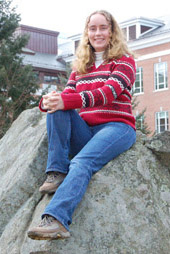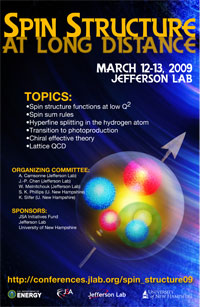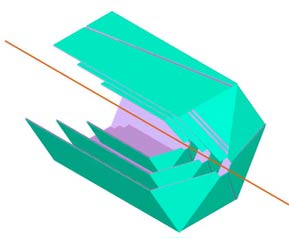Welcome
Welcome to the web pages of the UNH Nuclear and Particle Physics Group, which is part of the Physics Department. The group is currently located in our new building, the rebuilt DeMeritt Hall, which we moved into in August 2008. The Nuclear Physics Group’s (NPG) research is aimed at two primary areas of study:- Searches for physics beyond the Standard Model;
- Understanding the structure of the nucleon and light nuclei, and how this can be described in terms of the strong interaction and spin degrees of freedom.
We lead several multi-national collaborations at Jefferson Lab, and are preparing for several additional experiments at this facility. Jefferson Lab is presently completing a $314M upgrade, which was highlighted as the top priority of the last NSAC (National Science Advisory Committee) report. There are three full time faculty (Maurik Holtrop, Karl Slifer and Patricia Solvignon), and one 1/2 FTE faculty (John Calarco). Two postdoctoral research scientists (Elena Long and Rafayel Paramuzyan) and three graduate students (Toby Badman, Kyle McCarty, and Ryan Zielinski) work in the NPG on Jefferson Lab projects. Over the past decade we have mentored nine PhDs, and more than twenty undergraduates. These students make significant contributions to our efforts both at UNH and at Jefferson Lab, where they work side by side with some of the top scientists in the field. Our main experimental efforts are:
- The Heavy Photon Search (spokesperson: Holtrop) will search for a new gauge boson --the heavy photon-- as a potential Dark Matter candidate.
- The g2p experiment (spokesperson: Slifer) investigates the spin structure of the proton and how this affects the energy levels of hydrogen like systems.
- The Isospin SRC experiment (spokesperson: Solvignon) will use a tritium target to probe how short-range correlations between nucleons affect the structure of nuclei.
- The group also utilizes the Oak Ridge Spallation Neutron Source to study parity violating np capture (Calarco) to measure the weak charge of the pi meson, and the BLAST detector at DESY to search for deviations from the first Born approximation.
The NPG has two major research initiatives in DeMeritt Hall. The first is the development of a new detector array as part of a complex detector system to be used in Jefferson Lab's Hall B. The NPG has constructed an ISO 7/Class 10,000 clean room in DeMeritt Hall for testing of these Silicon Vertex Tracker modules. The group is also establishing a cryogenically cooled solid polarized target lab in DeMeritt Hall 103 in support of the Tensor Spin Observables program. We recently installed our new 7 Tesla superconducting solenoid which provides the target holding field. This project is a collaboration with the University of Virginia and Jefferson Lab polarized target groups.
News
A (Nuclear) Force To Be Reckoned With
NPG member Patricia Solvignon is being recognized for receiving a prestigious Early Career Research Grant from the U.S. Department of Energy.Tensor Asymmetry Experiment
NPG member Elena Long is the contact spokesperson for a proposal submitted to Jefferson Lab PAC 43 to measure the tensor elastic analyzing power T20 and the quasi-elastic asymmetry Azz.Tensor Spin Observables Workshop
NPG Members Slifer, Long and Solvignon were members of the organizing committee of the Tensor Spin Observables Workshop.Tensor Asymmetry Experiment
NPG Group member Elena Long is contact spokesperson for a Letter of Intent submitted to Jefferson Lab PAC 42.HPS Experiment in Nature News item.
The HPS experiment has a short article in Nature News: "Physicists hunt for dark forces". And a rewrite of this article appears in Popular Science: "While the LHC Hunts Higgs, the Jefferson Accelerator Looks to Illuminate Mysterious 'Dark Photons'.
Sarah receives JSA Postdoc Grant.

Sarah Phillips (photo: Dan Mannarino)
Our research scientist, Dr. Sarah Phillips, received the prestigeous JSA Postdoc Grant for her work on the "True Muonium" experiment. This experiment will look for true muonium, the mu+ mu- bound state, which has never been seen before. The experiment would use the same equipment as the Heavy Photon Search (HPS) experiment.
The Heavy Photon Experiment gets thumbs up.
The Heavy Photon Experiment (HPS) was just approved by PAC37. The full experiment will be conditional on a successful test run, which we hope to run in 2012, before the shutdown for the 12 GeV upgrade at Jefferson Lab.The HPS will make use of a new large acceptance, high luminosity spectrometer in Hall-B. Also approved, with A rating, is the APEX experiment, which will run in Hall-A, using the existing spectrometers. APEX will also search for the heavy photon.
New Postdoc joins our group.
We are very pleased to announce that Dr. Rafayel Paramuzyan has joined our group. Rafayel will be working on the Heavy Photon Search
Hovanes gets permanent position at Jlab
Our research scientist, Hovanes Egiyan, was awarded a permanent position as Jefferson Lab Hall-D staff, where he will be working on the Hall-D equipment and experiments. He continues his membership in the CLAS collaboration.
Spin Structure Workshop at Jefferson Lab

NPG members Karl Slifer and Sarah Phillips are part of the organizing committee for the Spin Structure at Long Distance Workshop that will be held at Jefferson Lab in Newport News, Virginia, on March 12th and 13th, 2009. The workshop covers the spin structure functions of the nucleon at low momentum transfer, with presentations by theoretical and experimental experts in the field. For more details, see the workshop website at Jefferson Lab.
This workshop is supported by the JSA Initiatives Fund, Jefferson Lab, and the University of New Hampshire.
New Faculty member joins
We are happy to welcome Prof. Patricia Solvignon, who will be joining the UNH Physics department faculty this Fall 2013 in a bridge position with Jefferson Lab.
Silicon Vertex Tracker Test Lab

Simulated picture of the SVT detector, part of the CLAS12 detector.
We just started a new project for the CLAS12 detector. We will be constucting a test lab for the Silicon Vertex tracker, the inner most detector system of the upgraded CLAS detector. A simulated picture of this detector is shown in the inset picture. The test lab will involve a complete detector readout system and an x-y-z positioning table, which will position a laser over the silicon detector to be tested.
